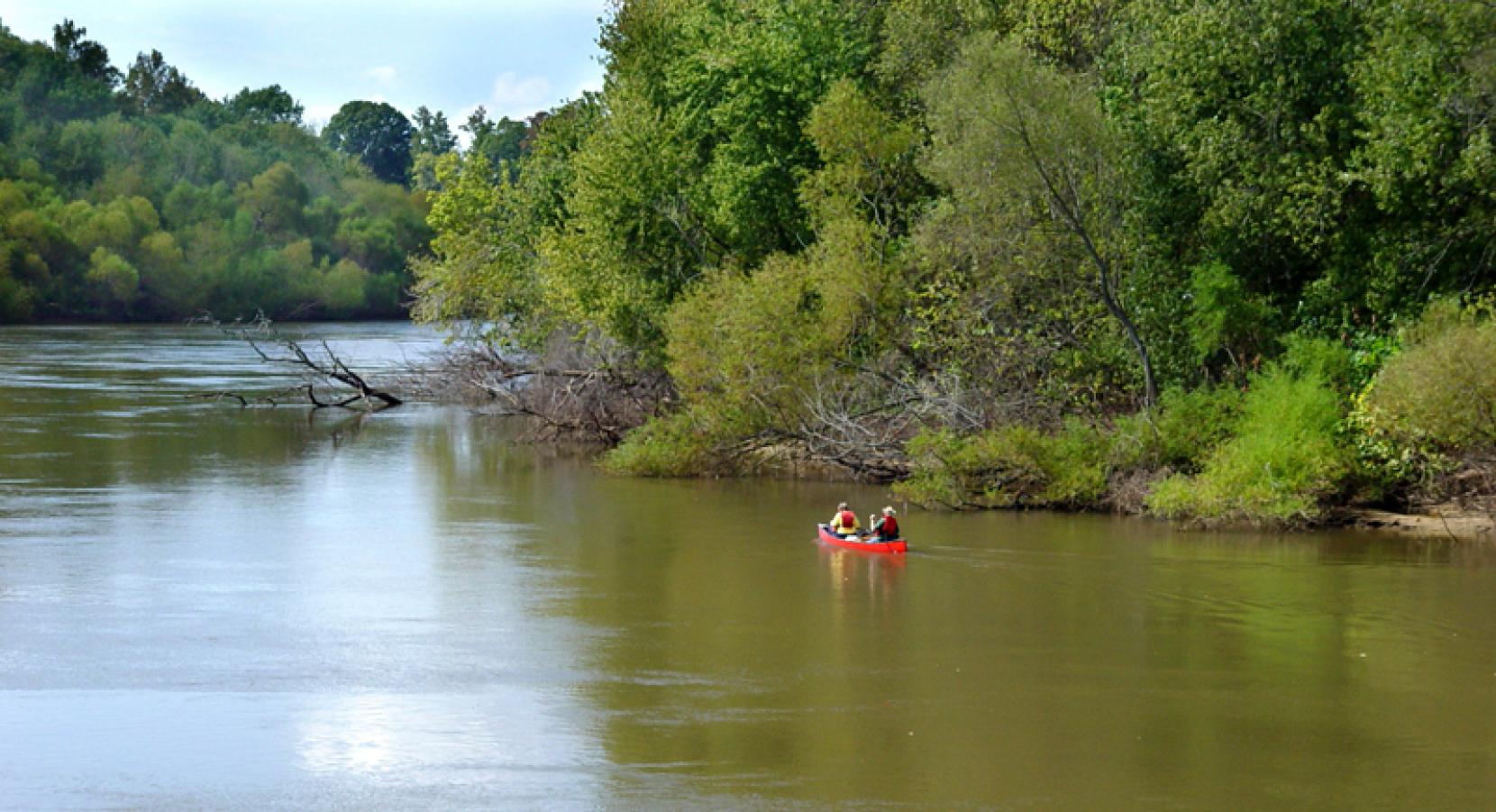Years of fierce fighting end with floodplain preserved
With the recent $3 million sale of 547 acres of floodplain property, a 20-year saga over a billion-dollar South Carolina development came to a long-awaited and satisfying conclusion.
There will be no 4,600-acre “city-within-a-city” south of Columbia, S.C., sitting in a floodway protected by levies that probably wouldn’t hold in a major flooding event but would often worsen flooding in neighboring areas.
Powerful, well-connected interests were not able to overrule the determinations of scientists and engineers or run roughshod over the interests of neighbors. This was a long-fought, hard-won victory, and SELC played a leading role.
When we’re in it, we’re in it for the long haul.
Blan Holman, Senior Attorney
The 4,600-acre area had been periodically-flooded farmland for hundreds of years. A consortium called Columbia Venture bought the land and sought public assistance to pay for a new levy system that would encircle a new development with thousands of people.
The project, called Green Diamond, would include golf courses, a hospital, 5,000 homes and a technology park. The Washington Post said it might be “the most ambitious development proposal in South Carolina history.”
But in 1998, the Federal Emergency Management Agency issued revised flood risk maps for the Congaree River flood plain. The maps showed Green Diamond was located in the regulatory floodway, an area that would experience major flooding – and that, if blocked, would raise flood levels on hundreds of nearby homes by three feet.
“The floodway designation keeps people out of harm’s way and also prevents the building of structures that block the flow of water and cause deeper flooding all around,” said Blan Holman, senior attorney at SELC’s Charleston office. “Communities benefit from having floodways to pass water downstream. Columbia Venture wanted to block the historic floodway with miles of levees and build a speculative development behind them.”
Burroughs & Chapin, the major stakeholder in Columbia Venture, had come to prominence by exploiting regulatory loopholes to develop thousands of acres of wetlands property in Myrtle Beach. It had powerful ties to South Carolina politicians and went to work influencing incoming Bush White House officials to undo FEMA’s floodway decision.
“They started pulling political strings and putting pressure on the Bush administration to get FEMA to back off,” Holman said. “This was a big deal nationally in terms of flood policy. The Clinton Administration had been working to get people out of harm’s way rather than bailing them out after they were flooded, but these guys wanted to reverse that.”
After SELC discovered the political pressure campaign to get the White House to reverse FEMA, it shared the information with the The Washington Post. And when FEMA didn’t initially back down, Columbia Venture sued to undo FEMA’s designation using new models that supposedly showed its land would not experience dangerous flooding.
SELC then intervened legally to defend FEMA’s decision.

This aerial image shows flooding at the site intended for the Green Diamond development. (©Congaree Riverkeeper)
The key issue was determining the likely volume of a 100-year flood and where its waters would go. FEMA had determined a 100-year flood would result in 300,000 cubic-feet of water per second flowing down the river. Columbia Venture said FEMA got the modeling wrong and the actual number was much lower, showing that its land would hardly flood at all.
John Grego, a statistician at the University of South Carolina and one of the clients represented by SELC, dug into the history of flooding in the region.
“I just started doing historical flood research,” Grego said. “I saw that some historic floods were being overlooked. The impact of the Lake Murray Dam on reducing floods was being overstated.”
Grego found accounts of floods in 1908 and 1964, including film footage of the later flood. “This was all happening in a period where Columbia hadn’t seen major flooding in years and years,” Grego said. “Those sorts of visuals were compelling — including photos of the Congaree River bursting through levies on the Columbia Venture property.”
“It was just fascinating and illuminating research,” Holman said. “We learned a lot about hydrology and why people had never developed that land. People had forgotten why.”
Residents of a small neighborhood across the river from the proposed development were concerned about what reinforced levies on the other side of the river would mean for them — and skeptical of reassurances from the developer’s engineers.
“They brought in a hydrologist from the West Coast to say the levies on the other side wouldn’t push the water over onto our side, just make it go faster,” said Chris Kueny, a 25-year resident of the Riverside Park neighborhood. “All you need to disprove that is a water balloon!”
The neighbors had more than a water balloon, though. Dan Tufford, another researcher at USC, had been opposed to Green Diamond since it was announced.
“I’d been involved in the environmental community for several years when this thing came up,” he said. “I got involved purely from the perspective of environmental advocacy and not wanting to see that flood plain turned into a developed community. But as things progressed, it became clear that there was a possible role for me using my professional expertise.”
Columbia Venture was using computer model simulations to argue that FEMA’s calculations were incorrect. Tufford hadn’t used the software package they were using, but had significant experience with modeling surface water movement in rivers and reservoirs.

Canoers enjoy a day out on the Congaree River. (©William Graf)
“One of the things we as a team were concerned about was whether their engineering consultants had A) done a reasonable job of characterizing what the impact of the development would be on that location and b) were accurately presenting the results of the simulation models they were doing,” Tufford said.
When Tufford looked at the same models, he came to different conclusions. “We interpreted the models to show there would be a substantial and devastating impact on the community,” he said.
The fight against Green Diamond was a team effort, Tufford said. “There were a lot of people involved,” he said. “John Grego was a key part. SELC was an essential part of this, along with numerous members of the business community that clearly understood this was not going to be a good thing. It was a multi-pronged and multidisciplinary effort.”
The legal fights were fierce. After Columbia Venture won the first round in federal district court, SELC won a rare stay pending appeal and had the decision reversed in full. Burroughs & Chapin subsequently sued Richland County, claiming its flood rules constituted a taking under the U.S. Constitution. In 2015, the South Carolina Supreme Court ruled in favor of the county.
A couple months after ruling, a rain-swollen Congaree River flooded the entire parcel. Kueny said water came up to his backyard, and the river came over the bank at the lowest part of the neighborhood. If Green Diamond had been built, he said he is sure the flooding would have hit his neighborhood hard.
“It would have completely eliminated us,” he said. “Everything would have been under 20 feet of water.”
Tufford agreed. “I didn’t do a numerical analysis, but if you look at the flood stage and the river flow, it’s clear there would have been a lot of devastation there.”
In March of this year, USC agreed to buy the last 547 acres left in the parcel. It will use the property to build recreation fields and conduct agricultural research. Congaree Riverkeeper Bill Stangler called that, “the best use of this property.”
Reflecting on the twenty-year saga in his home town, Holman pointed to SELC’s persistence and its deep community connection. “When we’re in it, we’re in it for the long haul,” he said.
